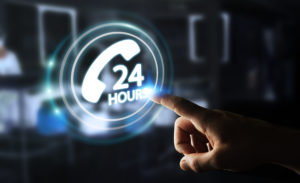FCC Wants You to Dial 988 Before It’s Too Late: Abbreviated 3-Digit Access to Suicide Help Line Proposed
 The Federal Communication Commission ("FCC") has proposed to establish "988" as a nationwide abbreviated telephone dialing code to reach the National Suicide Prevention and Mental Health Crisis hotline. An 800 number (1-800-273-TALK) already universally connects to suicide counselors, but people facing a suicide crisis might not remember such a long number. The same hotline will remain in service, but the FCC is now proposing 3-digit dialing access.
The Federal Communication Commission ("FCC") has proposed to establish "988" as a nationwide abbreviated telephone dialing code to reach the National Suicide Prevention and Mental Health Crisis hotline. An 800 number (1-800-273-TALK) already universally connects to suicide counselors, but people facing a suicide crisis might not remember such a long number. The same hotline will remain in service, but the FCC is now proposing 3-digit dialing access.
Suicide prevention is a serious challenge. The Centers for Disease Control and Prevention ("CDC") reports that in 2017, more than 47,000 Americans died by suicide, and more than 1.4 million adults attempted suicide. Suicide is the second most common cause of death among teenagers and young adults. These numbers have risen sharply in the past 20 years. Almost 80% of callers to the 800 number reported that follow-up calls stopped them from killing themselves.
Congress passed the National Suicide Hotline Improvement Act of 2018, directing the FCC and other agencies to analyze the effectiveness of the hotline and to consider the feasibility of a 3-digit abbreviated dialing code. An "N11" number would be the easiest for people to remember, but all of the available N11 codes are currently in use. For those who don't think that is so, here is the line-up.
111: not available - triggers non-local (long distance) call routing
211: community information and referral services
311: non-emergency police and other governmental services calls
411: directory assistance in some places
511: traveler information services
611: telephone company service calls
711: Telecommunications Relay Service (for people with hearing loss)
811: notice of excavations ("Call before you dig")
911: police and fire emergencies
All of these numbers except 411 and 611 have been permanently assigned by the FCC, but 611 and 411 are the first and third most heavily used numbers. Indeed, all of the N11 numbers are heavily used; the estimated traffic on all existing N11 numbers is almost 608 million calls a year. The FCC has tentatively concluded that repurposing any of them and getting the public used to the change would take many years and a lot more time than initiating suicide hotline access using a new 3-digit number, and the need for prompt action outweighs the possible greater recognition that an N11 number might have.
Some people have advocated expanding 211 to include access to the suicide hotline, but the FCC concluded that requiring a suicide assistance call to go through an automated menu, or even a live attendant, for routing could result in delay or errors that would cause a help call to be abandoned.
The process of universally establishing the 988 dialing code is not exactly simple. Because "988" is not assigned as an Area Code in the North American Numbering Plan, the Plan Administrator will not face the problem of changing the area code that a lot of people are accustomed to using. However, there are still 95 Area Codes that permit 7-digit dialing for local calling. Not many Area Codes have a "988" local exchange, but some do. In those situations, either 10-digit dialing would have to be made mandatory for all calls or else the local telephone company switch would have to wait after receiving "988" and connect to the suicide hotline if no other digits were dialed after a specified number of seconds. The latter approach could result in undesirable delay in connecting a call and some non-emergency calls being erroneously routed to the hotline. The FCC asks whether it should mandate 10-digit dialing for everyone or allow state commissions decide how to handle the problem.
The FCC proposes to require every provider of local telephone service to implement 988 dialing within 18 months. It estimates that as many as 6,000 local switches will have to be replaced, because they cannot be reprogrammed; and the FCC tentatively proposes to not to reimburse the cost. Voice over Internet Protocol (VoIP) carriers - like phones you get from your cable company, Vonage, or other similar applications that connect only to the Internet - will also be required to conform at their own expense. The FCC does a cost-benefit analysis, estimating $570 million in first-year costs and lesser ongoing costs thereafter; but with the dollar value that the government commonly assigns to each life saved ($9.6 million), the benefits quickly outweigh the costs if the suicide rate is reduced by as little as 0.1%.
The FCC poses one final somewhat disruptive question: Millennials and Generation Zers rarely talk on the phone; they send text messages. Will people contemplating suicide pick up the phone and call 988, or will they try to send a text to 988? Texts to 3-digit codes don't go anywhere, so the FCC asks what we can do about that.
Unless the FCC has missed some really serious obstacles, the 988 proposal is likely to be adopted. Comments will be due 30 days after publication of the proposals in the Federal Register. Watch www.commlawblog.com for news of when the comment deadline is announced.